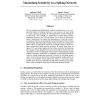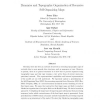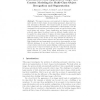129 search results - page 20 / 26 » Receptive Field Structures for Recognition |
NIPS
2004
13 years 9 months ago
2004
We use unsupervised probabilistic machine learning ideas to try to explain the kinds of learning observed in real neurons, the goal being to connect abstract principles of self-or...
NECO
2006
13 years 7 months ago
2006
Recently, there has been an outburst of interest in extending topographic maps of vectorial data to more general data structures, such as sequences or trees. However, at present, ...
TCSV
2008
13 years 7 months ago
2008
Efficiently and accurately detecting pedestrians plays a very important role in many computer vision applications such as video surveillance and smart cars. In order to find the ri...
ICDAR
2007
IEEE
14 years 1 months ago
2007
IEEE
The Machine Learning and Pattern Recognition communities are facing two challenges: solving the normalization problem, and solving the deep learning problem. The normalization pro...
ECCV
2006
Springer
14 years 9 months ago
2006
Springer
Abstract. This paper proposes a new approach to learning a discriminative model of object classes, incorporating appearance, shape and context information efficiently. The learned ...



